High Impact Tutoring Built By Math Experts
Personalized standards-aligned one-on-one math tutoring for schools and districts
Cone
Here you will learn about cones, including how to classify and identify a cone, how to find the volume of a cone and how to find the surface area of a cone.
Students will first learn about a cone as part of geometry in katex is not definedst grade. They will expand their learning in middle school and high school when they learn how to find the volume and surface area of a cone.
What is a cone?
A cone is a three dimensional object that tapers from a circular base to a point. The term cone comes from the Greek word, “konos”, meaning a wedge or peak.
There is more than one type of cone, and the cone most commonly used is referred to as a “right circular cone”.
Examples of cones:
| Right circular cone | Oblique cone |
|---|---|
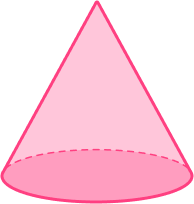 |
 |
Real-life examples of cone like shapes include traffic cones, ice cream cones, volcano shapes, and party hats.
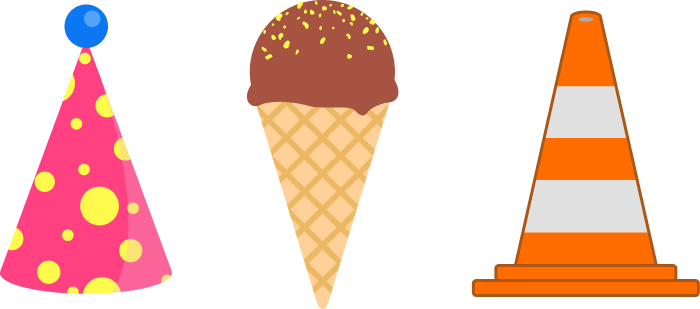
Parts of a cone:
Base
The base of the cone is a circle.
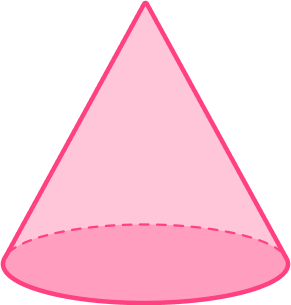
Vertex or apex
The vertex or apex of the cone is the point where all lateral sides meet.
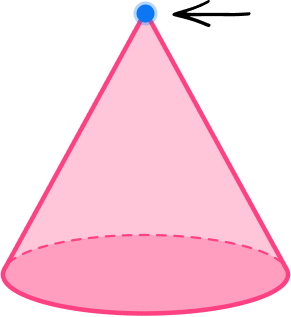
Dimensions of a cone
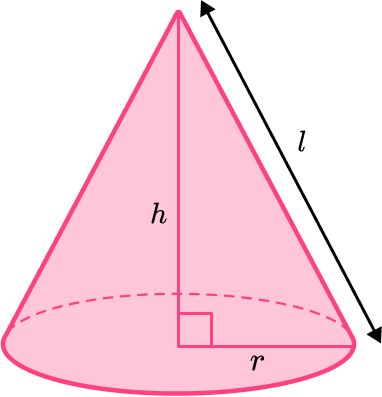
The radius of the base of a cone is katex is not defined.
The perpendicular height of a cone is katex is not defined. The height of the cone is a line segment that connects the apex to the center of the circular base. It is perpendicular to the base of the cone.
The slant height of a cone is katex is not defined. The slant height of the cone is the distance from any point on the base to the apex, along the curved surface of the cone.
Volume of a cone
The volume of a cone is how much space there is inside a cone.
The formula for the volume of a cone is:
katex is not defined
For example, find the volume of the cone, rounded to the nearest tenth.
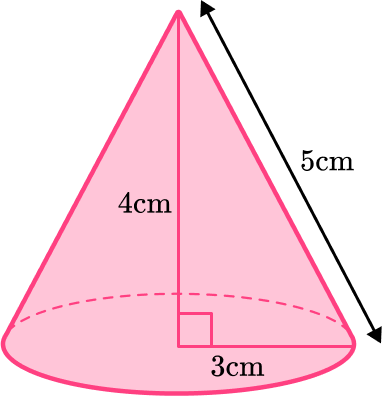
katex is not defined
Surface area of a cone
The surface area of a cone is the area which covers the outer surface of a cone.
The surface area is made up of two parts, a curved surface area and a circular base.
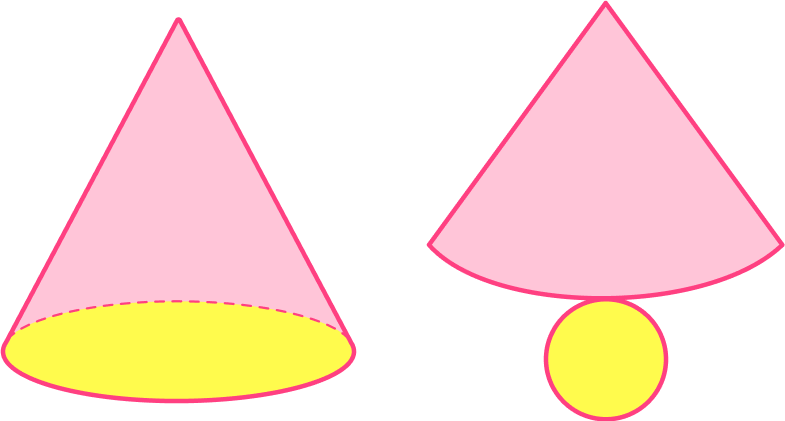
The formula for calculating the curved surface area of a cone is:
katex is not defined
The formula for calculating the area of a circle:
katex is not defined
For the TOTAL surface area, you can add the two parts together:
katex is not defined
For example, find the surface area rounded to the nearest tenth.

katex is not defined
katex is not defined
katex is not defined
What is a cone?
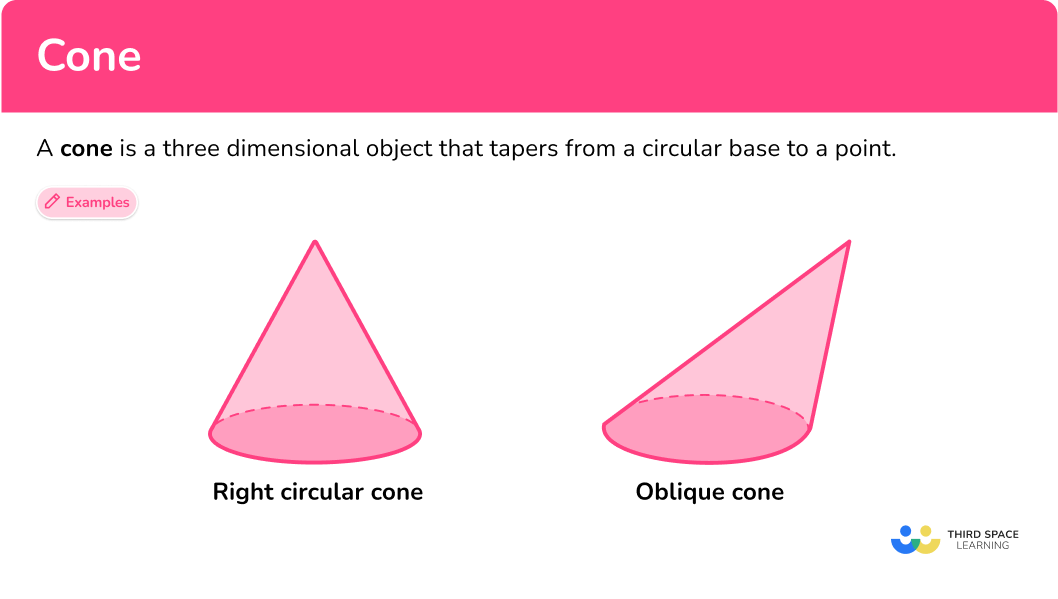
Common Core State Standards
How does this relate to katex is not definedst, katex is not definedth and katex is not definedth grade math?
- Grade 1: Geometry (1.G.A.2)
Compose two-dimensional shapes (rectangles, squares, trapezoids, triangles, half-circles, and quarter-circles) or three-dimensional shapes (cubes, right rectangular prisms, right circular cones, and right circular cylinders) to create a composite shape, and compose new shapes from the composite shape.
- Grade 7: Geometry (7.G.B.6)
Solve real-world and mathematical problems involving area, volume and surface area of two- and three-dimensional objects composed of triangles, quadrilaterals, polygons, cubes, and right prisms.
- Grade 8: Geometry (8.G.C.9)
Know the formulas for the volumes of cones, cylinders, and spheres and use them to solve real-world and mathematical problems.
How to identify a cone
In order to identify a cone, you will:
- Look for the characteristics of a cone.
- State whether or not the shape is a cone.
- If the shape is not a cone, explain what characteristics are different.
![[FREE] 3D Shape Check for Understanding (Grade 1, 5 and 6)](https://thirdspacelearning.com/wp-content/uploads/2023/11/3D-Shape-listing-image.png)
[FREE] 3D Shape Check for Understanding (Grade 1, 5 and 6)
![[FREE] 3D Shape Check for Understanding (Grade 1, 5 and 6)](https://thirdspacelearning.com/wp-content/uploads/2023/11/3D-Shape-listing-image.png)
Use this quiz to check your grade 1, 5 and 6 students’ understanding of 3D shape. 10+ questions with answers covering a range of 1st, 5th and 6th grade 3D shape topics to identify areas of strength and support!
DOWNLOAD FREE![[FREE] 3D Shape Check for Understanding (Grade 1, 5 and 6)](https://thirdspacelearning.com/wp-content/uploads/2023/11/3D-Shape-listing-image.png)
[FREE] 3D Shape Check for Understanding (Grade 1, 5 and 6)
![[FREE] 3D Shape Check for Understanding (Grade 1, 5 and 6)](https://thirdspacelearning.com/wp-content/uploads/2023/11/3D-Shape-listing-image.png)
Use this quiz to check your grade 1, 5 and 6 students’ understanding of 3D shape. 10+ questions with answers covering a range of 1st, 5th and 6th grade 3D shape topics to identify areas of strength and support!
DOWNLOAD FREECone examples
Example 1: cone example
Look at the image below and determine if it is a cone or not.
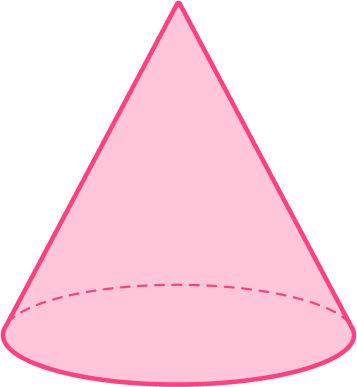
- Look for the characteristics of a cone.
A cone has a circular base with a curved surface area that meets at a vertex that is directly above the center of the circular base.
This shape also has a circular base and a curved surface area that meets at a vertex.
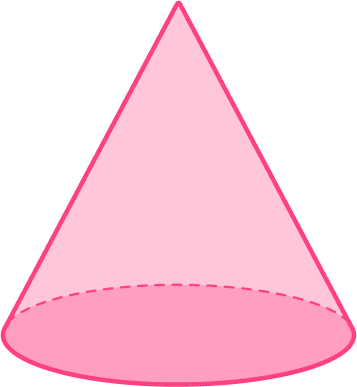
2State whether or not the shape is a cone.
This shape is a cone because it has a circular base with a curved surface that meets at a vertex.
Example 2: cone example
Look at the image below and determine if it is a cone or not.
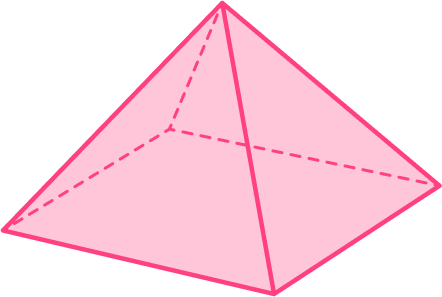
Look for the characteristics of a cone.
A cone has a circular base with a curved surface area that meets at a vertex that is directly above the center of the circular base.
This shape has a rectangular base with katex is not defined triangular faces that meet at a vertex.
State whether or not the shape is a cone.
This shape is a pyramid, not a cone.
If the shape is not a cone, explain what characteristics are different.
This shape has a rectangular base with katex is not defined triangular faces that meet at a vertex.
How to calculate the volume of a cone
In order to calculate the volume of a cone:
- Write down the formula.
- Substitute the given values.
- Calculate the volume of the cone.
- Write the final answer, including the units.
Volume of a cone examples
Example 3: volume of a cone
Find the volume of the cone with radius katex is not defined and perpendicular height katex is not defined.
Give your answer to the nearest centimeter.
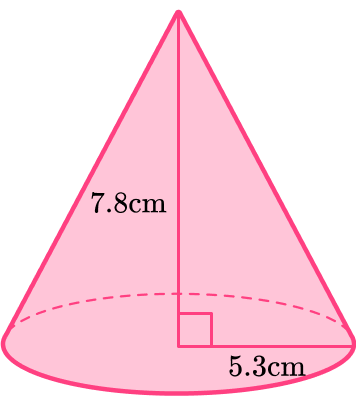
Write down the formula.
katex is not defined
Substitute the given values.
katex is not defined
katex is not defined
Calculate the volume of the cone.
katex is not defined
Write the final answer, including the units.
The answer rounded to the nearest centimeter is katex is not defined.
Example 4: volume of a cone
Find the volume of the cone with radius katex is not defined and perpendicular height katex is not defined.
Leave your answer in terms of katex is not defined.
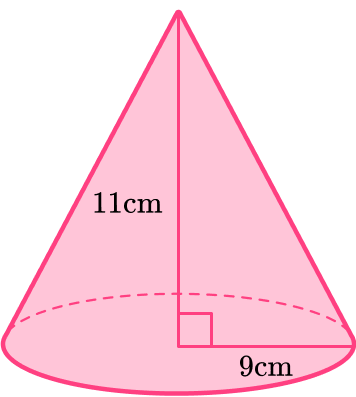
Write down the formula.
katex is not defined
Substitute the given values.
katex is not defined
katex is not defined
Calculate the volume of the cone.
katex is not defined
Write the final answer, including the units.
The question asks for the answer in terms of katex is not defined so the final answer is
katex is not defined
How to calculate the surface area of a cone
In order to calculate the surface area of a cone:
- Calculate the area of each face.
- Add the area of each face together.
- Include the units.
Surface area of a cone examples
Example 5: total surface area of a cone
Find the curved surface area of the cone with radius katex is not defined and slant height katex is not defined.
Give your answer to the nearest centimeter.
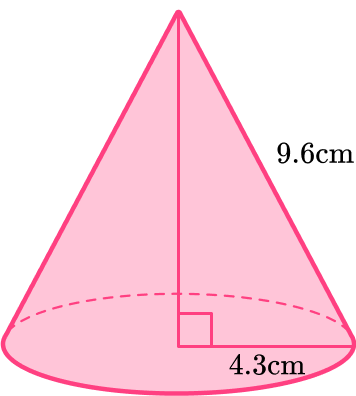
Calculate the area of each face.
katex is not defined
katex is not defined
Add the area of each face together.
Total surface area: katex is not defined
Include units.
Surface area katex is not defined
Example 6: total surface area of a cone
Find the curved surface area (lateral area) of the cone with radius katex is not defined and slant height katex is not defined.
Leave your answer in terms of katex is not defined.
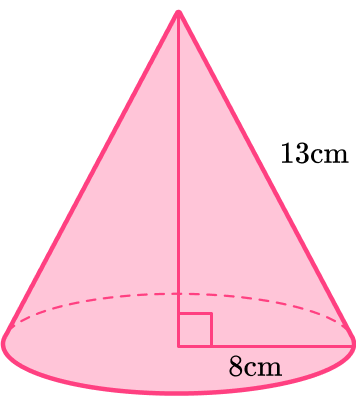
Calculate the area of each face.
katex is not defined
katex is not defined
Add the area of each face together.
Total surface area: katex is not defined
Include units.
katex is not defined
Teaching tips for cone
- Introduce and reinforce important vocabulary words, such as base, vertex, height, slant height, lateral surface area, and volume. Make sure to encourage students to use these terms correctly when discussing cones.
- Provide hands-on activities for students to explore and manipulate cone shapes. For example, you can give them playdough or clay to create their own cones, or ask them to cut out and fold paper cones.
- Allow students to practice calculating the volume and surface area of cones. You can also give them worksheets or problem-solving tasks involving cone calculations to reinforce their understanding.
Easy mistakes to make
- Incorrectly applying a formula
There are several formulas that can be used, so you would need to match the correct formula to the correct context.
For example, it would be easy to mix up katex is not defined, the formula to find the area of a circle, and the formula to find the volume of a cone,
katex is not defined
- Confusing the radius and diameter
It is a common error to mix up radius and diameter. Remember, the radius of the cone is half of the distance across the circular base, and the diameter is the full distance across the circular base.
For example,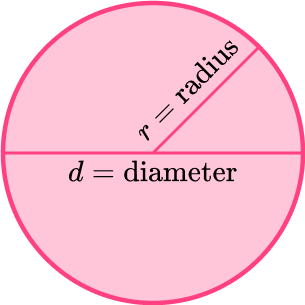
- Use of incorrect units
It’s easy for students to mix up when to use the different types of units. For area, you use square units such as katex is not defined, and for volume, you use cubic units such as katex is not defined.
Related 3D shape lessons
- Hemisphere shape
- Sphere shape
- Triangular pyramid
- Pyramid shape
- Square pyramid
- 3D shape names
- Cylinder
- Angles of elevation and depression
Practice cone questions
1) Which shape is an example of a cone?
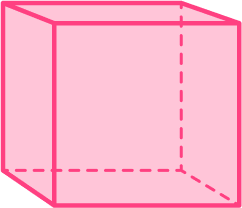

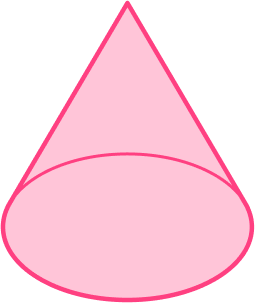

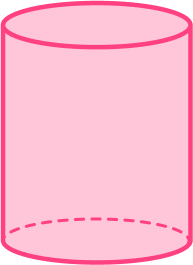

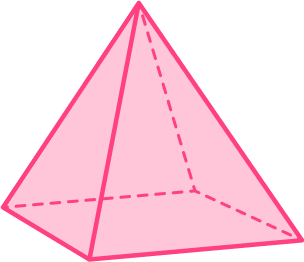

This shape has a circular base with a curved surface area that meets at a vertex that is directly above the center of the circular base.
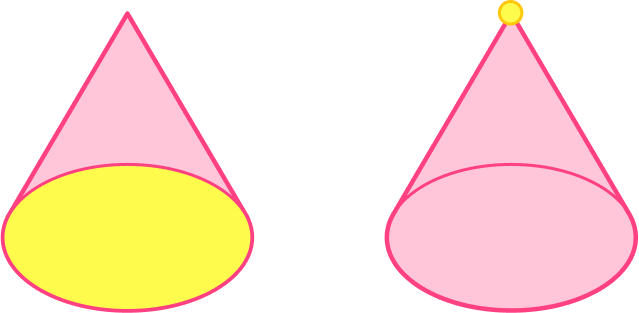
This shape is a cone.
2) Which shape is an example of a cone?
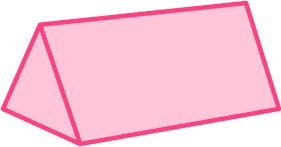

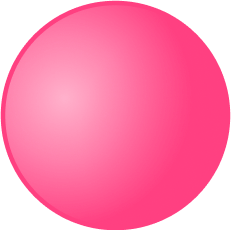

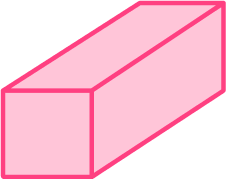

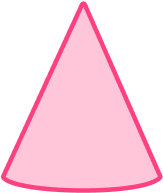

This shape has a circular base with a curved surface area that meets at a vertex that is directly above the center of the circular base.

This shape is a cone.
3) Find the volume of a cone to the nearest whole cubic centimeter with a radius of katex is not defined and perpendicular height of katex is not defined.





Find the volume of a cone so you can substitute the values of katex is not defined and katex is not defined into the formula.
katex is not defined
katex is not defined
katex is not defined
(katex is not defined rounded to the nearest whole number would give you…)
katex is not defined
4) Find the volume of a cone of radius katex is not defined and perpendicular height katex is not defined. Leave your answer in terms of katex is not defined.
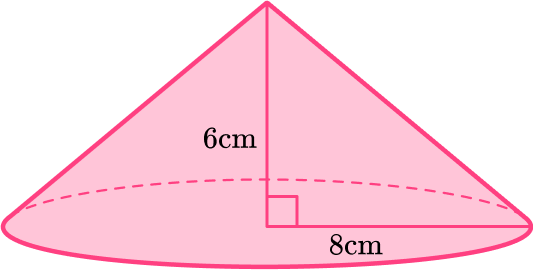




Find the volume of a cone so you can substitute the values of katex is not defined and katex is not defined into the formula.
katex is not defined
5) Find the curved surface area (lateral area) of a cone of radius katex is not defined and slant height katex is not defined.
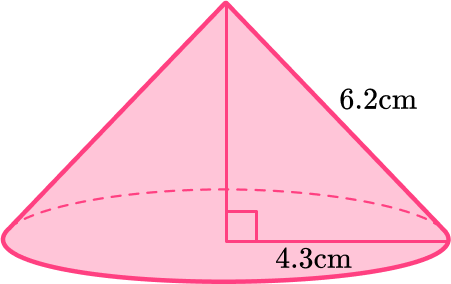




You will find the curved surface area of a cone, so you can substitute the values of katex is not defined and katex is not defined into the formula.
katex is not defined
6) Find the curved surface area (lateral area) of a cone of radius katex is not defined and slant height katex is not defined. Leave your answer in terms of katex is not defined.
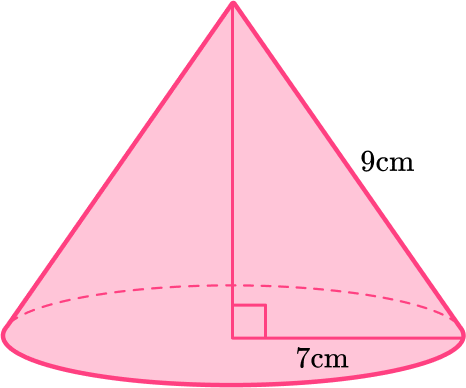




You are finding the curved surface area of a cone, so substitute the values of katex is not defined and katex is not defined into the formula.
katex is not defined
Cone FAQs
A right circular cone is the most common type of cone. It has a circular base, and the apex is directly above the center of the base. The axis of the cone is perpendicular to the base, creating a right angle. An oblique cone is any cone that is not a right circular cone. In an oblique cone, the axis is not perpendicular to the base, resulting in a slanted shape.
During your math journey, you will encounter right circular cones, oblique cones, acute cones, and obtuse cones.
The next lessons are
Still stuck?
At Third Space Learning, we specialize in helping teachers and school leaders to provide personalized math support for more of their students through high-quality, online one-on-one math tutoring delivered by subject experts.
Each week, our tutors support thousands of students who are at risk of not meeting their grade-level expectations, and help accelerate their progress and boost their confidence.

Find out how we can help your students achieve success with our math tutoring programs.
[FREE] Common Core Practice Tests (Grades 3 to 6)
Prepare for math tests in your state with these Grade 3 to Grade 6 practice assessments for Common Core and state equivalents.
40 multiple choice questions and detailed answers to support test prep, created by US math experts covering a range of topics!